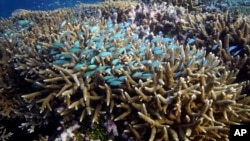One of the world's largest marine citizen science projects has surveyed its 500th section of Australia’s Great Barrier Reef since the effort began in 2020. This year’s Great Reef Census, which runs from September to December, has revealed severe damage to the coral, while other parts of the 2,300-kilometer World Heritage site are thriving. The Great Barrier Reef is made up of about 3,000 individual reefs, making it the world's largest coral system.
The annual reconnaissance of the Great Barrier Reef off northeastern Australia has produced tens of thousands of images.
They have been taken by divers and snorkelers onboard more than 60 dive boats, tourism vessels, sailing boats, super-yachts and tugboats, who are surveying the far reaches of the world’s largest coral system.
They have visited 500 individual reefs during the past three years. The photographs paint a picture of the health of the world’s largest coral system, providing data on the types of coral and their coverage at each reef.
“Reaching 500 reefs through the Great Reef Census is a massive achievement for the community,” said Andy Ridley, chief executive officer of Citizens of the Great Barrier Reef, which organizes the survey. “It just goes to prove how a motley flotilla of all sorts of vessels can reach such an enormous amount of area bearing in mind the Great Barrier Reef is the same size of Germany. We have reached about 15% of the reefs, which is amazing.”
Early results from the survey have shown some parts of the Great Barrier Reef are flourishing. Others, though, have been damaged by warmer ocean temperatures and more intense tropical storms caused by climate change as well as coral-eating crown of thorns starfish.
There are other threats, too, including overfishing, pollution and the industrialization of the Queensland coast.
Starting in March, citizen-scientists from across the world will be able to join the project by helping to analyze the images from the expeditions.
The Great Reef Census is a partnership with the University of Queensland, the Great Barrier Reef Marine Park Authority, which administers the region, James Cook University, the Australian Institute of Marine Science and several technology companies.
The surveillance project on what is arguably Australia’s greatest natural treasure has become so big that artificial intelligence is being used to scan much of the data, but Ridley has stressed that citizen-scientists, or virtual volunteers, have a critical part to play.
The Great Barrier Reef is so vast that it is the only living thing visible from space.









